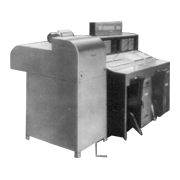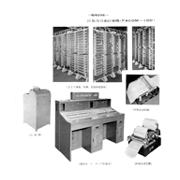Published on Jun. 1, 2006
Last updated on Jul. 8, 2023
This was Japan's first practical relay-based automatic computer. It was developed in October 1954 by Fuji Tsushinki Seizo. The main unit of the FACOM 100 was comprised of approximately 4,500 relays. Circuit control was asynchronous, and programs were executed by reading from 60-unit paper tape (non-combustible film was used for repeatedly used programs). For numerical values, the system used the floating point number which could handle a range from positive/negative 99-digit integers to 99 digits after the decimal point (with 8 significant digits), and arithmetic was done using the binary coded decimal method. Arithmetic speed performance for 8 digits was 0.35 seconds for addition and subtraction, 1.8 seconds for multiplication and 5.0 seconds for division. A self-check function was used due to issues of relay reliability, and the system always checked that there were no errors in calculation results in any arithmetic process. If an error was found, the arithmetic was retried. If no error occurred, the calculation continued. If an error was found the second time too, the machine stopped and the malfunction point was clearly indicated with indicator lamps. Relays were mounted in a total of 13 relay stands -- 5 for arithmetic, 4 for control and 4 for memory. The system was huge, taking up space of about 40 square meters, and could not be moved, but it had a calculation speed 40 to 100 times faster than humans performing calculations using aids like electrically-driven calculators so it was used to provide contracted computing services ordered by companies and universities.



